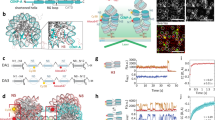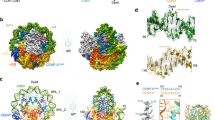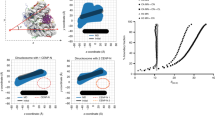Abstract
The histone H3 variant CENP-A is incorporated into nucleosomes that mark centromere location. We have recently reported that CENP-A nucleosomes, compared with their H3 counterparts, confer an altered nucleosome shape. Here, using a single-molecule fluorescence resonance energy transfer (FRET) approach with recombinant human histones and centromere DNA, we found that the nucleosome shape change directed by CENP-A is dominated by lateral passing of two DNA gyres (gyre sliding). A nonhistone centromere protein, CENP-C, binds and reshapes the nucleosome, sliding the DNA gyres back to positions similar to those in canonical nucleosomes containing conventional histone H3. The model that we generated to explain the CENP-A–nucleosome transition provides an example of a shape change imposed by external binding proteins and has notable implications for understanding of the epigenetic basis of the faithful inheritance of centromere location on chromosomes.
This is a preview of subscription content, access via your institution
Access options
Subscribe to this journal
Receive 12 print issues and online access
$189.00 per year
only $15.75 per issue
Buy this article
- Purchase on Springer Link
- Instant access to full article PDF
Prices may be subject to local taxes which are calculated during checkout



Similar content being viewed by others
References
Sekulic, N. & Black, B.E. Molecular underpinnings of centromere identity and maintenance. Trends Biochem. Sci. 37, 220–229 (2012).
Allshire, R.C. & Karpen, G.H. Epigenetic regulation of centromeric chromatin: old dogs, new tricks? Nat. Rev. Genet. 9, 923–937 (2008).
Westhorpe, F.G. & Straight, A.F. The centromere: epigenetic control of chromosome segregation during mitosis. Cold Spring Harb. Perspect. Biol. 7, a015818 (2015).
Warburton, P.E. et al. Immunolocalization of CENP-A suggests a distinct nucleosome structure at the inner kinetochore plate of active centromeres. Curr. Biol. 7, 901–904 (1997).
Amor, D.J. et al. Human centromere repositioning “in progress”. Proc. Natl. Acad. Sci. USA 101, 6542–6547 (2004).
Bassett, E.A. et al. Epigenetic centromere specification directs aurora B accumulation but is insufficient to efficiently correct mitotic errors. J. Cell Biol. 190, 177–185 (2010).
Earnshaw, W.C. & Migeon, B.R. Three related centromere proteins are absent from the inactive centromere of a stable isodicentric chromosome. Chromosoma 92, 290–296 (1985).
Barnhart, M.C. et al. HJURP is a CENP-A chromatin assembly factor sufficient to form a functional de novo kinetochore. J. Cell Biol. 194, 229–243 (2011).
Hori, T., Shang, W.-H., Takeuchi, K. & Fukagawa, T. The CCAN recruits CENP-A to the centromere and forms the structural core for kinetochore assembly. J. Cell Biol. 200, 45–60 (2013).
Chen, C.-C. et al. CAL1 is the Drosophila CENP-A assembly factor. J. Cell Biol. 204, 313–329 (2014).
Logsdon, G.A. et al. Both tails and the centromere targeting domain of CENP-A are required for centromere establishment. J. Cell Biol. 208, 521–531 (2015).
Tachiwana, H. et al. HJURP involvement in de novo CenH3(CENP-A) and CENP-C recruitment. Cell Rep. 11, 22–32 (2015).
Mendiburo, M.J., Padeken, J., Fülöp, S., Schepers, A. & Heun, P. Drosophila CENH3 is sufficient for centromere formation. Science 334, 686–690 (2011).
Guse, A., Carroll, C.W., Moree, B., Fuller, C.J. & Straight, A.F. In vitro centromere and kinetochore assembly on defined chromatin templates. Nature 477, 354–358 (2011).
Falk, S.J. et al. Chromosomes. CENP-C reshapes and stabilizes CENP-A nucleosomes at the centromere. Science 348, 699–703 (2015).
Sekulic, N., Bassett, E.A., Rogers, D.J. & Black, B.E. The structure of (CENP-A–H4)2 reveals physical features that mark centromeres. Nature 467, 347–351 (2010).
Carroll, C.W., Milks, K.J. & Straight, A.F. Dual recognition of CENP-A nucleosomes is required for centromere assembly. J. Cell Biol. 189, 1143–1155 (2010).
Kato, H. et al. A conserved mechanism for centromeric nucleosome recognition by centromere protein CENP-C. Science 340, 1110–1113 (2013).
Luger, K., Mäder, A.W., Richmond, R.K., Sargent, D.F. & Richmond, T.J. Crystal structure of the nucleosome core particle at 2.8 Å resolution. Nature 389, 251–260 (1997).
Harp, J.M. et al. X-ray diffraction analysis of crystals containing twofold symmetric nucleosome core particles. Acta Crystallogr. D Biol. Crystallogr. 52, 283–288 (1996).
Hasson, D. et al. The octamer is the major form of CENP-A nucleosomes at human centromeres. Nat. Struct. Mol. Biol. 20, 687–695 (2013).
Lee, J.Y. & Lee, T.-H. Effects of DNA methylation on the structure of nucleosomes. J. Am. Chem. Soc. 134, 173–175 (2012).
Lee, J.Y., Wei, S. & Lee, T.-H. Effects of histone acetylation by Piccolo NuA4 on the structure of a nucleosome and the interactions between two nucleosomes. J. Biol. Chem. 286, 11099–11109 (2011).
Ngo, T.T.M. & Ha, T. Nucleosomes undergo slow spontaneous gaping. Nucleic Acids Res. 43, 3964–3971 (2015).
Tachiwana, H. et al. Crystal structure of the human centromeric nucleosome containing CENP-A. Nature 476, 232–235 (2011).
Ong, M.S., Richmond, T.J. & Davey, C.A. DNA stretching and extreme kinking in the nucleosome core. J. Mol. Biol. 368, 1067–1074 (2007).
Vasudevan, D., Chua, E.Y.D. & Davey, C.A. Crystal structures of nucleosome core particles containing the '601' strong positioning sequence. J. Mol. Biol. 403, 1–10 (2010).
Tan, S. & Davey, C.A. Nucleosome structural studies. Curr. Opin. Struct. Biol. 21, 128–136 (2011).
Lacoste, N. et al. Mislocalization of the centromeric histone variant CenH3/CENP-A in human cells depends on the chaperone DAXX. Mol. Cell 53, 631–644 (2014).
Foltz, D.R. et al. The human CENP-A centromeric nucleosome-associated complex. Nat. Cell Biol. 8, 458–469 (2006).
Okada, M. et al. The CENP-H–I complex is required for the efficient incorporation of newly synthesized CENP-A into centromeres. Nat. Cell Biol. 8, 446–457 (2006).
Heun, P. et al. Mislocalization of the Drosophila centromere-specific histone CID promotes formation of functional ectopic kinetochores. Dev. Cell 10, 303–315 (2006).
Van Hooser, A.A. et al. Specification of kinetochore-forming chromatin by the histone H3 variant CENP-A. J. Cell Sci. 114, 3529–3542 (2001).
Gascoigne, K.E. et al. Induced ectopic kinetochore assembly bypasses the requirement for CENP-A nucleosomes. Cell 145, 410–422 (2011).
Warburton, P.E. Chromosomal dynamics of human neocentromere formation. Chromosome Res. 12, 617–626 (2004).
Wei, S., Falk, S.J., Black, B.E. & Lee, T.-H. A novel hybrid single molecule approach reveals spontaneous DNA motion in the nucleosome. Nucleic Acids Res. 43, e111 (2015).
Brunger, A.T. Version 1.2 of the Crystallography and NMR system. Nat. Protoc. 2, 2728–2733 (2007).
Davey, G.E., Wu, B., Dong, Y., Surana, U. & Davey, C.A. DNA stretching in the nucleosome facilitates alkylation by an intercalating antitumour agent. Nucleic Acids Res. 38, 2081–2088 (2010).
Sambrook, J. & Russell, D. Molecular Cloning: A Laboratory Manual (Cold Spring Harbor Laboratory Press, 2001).
Acknowledgements
We thank K. Gupta (University of Pennsylvania) for advice on modeling, C. Davey (Nanyang Technical University) and U. Surana (Agency for Science, Technology and Research, Singapore) for advice on ENA experiments and D. Cleveland (University of California, San Diego), K. Luger (University of Colorado) and A. Straight (Stanford University) for plasmids. This work was supported by US National Institutes of Health grants GM082989 (B.E.B.) and GM097286 (T.-H.L.), and a postdoctoral fellowship from the American Cancer Society (N.S.). We acknowledge support from a University of Pennsylvania Genetics Training Grant (US National Institutes of Health grant GM008216 supporting S.J.F.).
Author information
Authors and Affiliations
Contributions
S.J.F., J.L., N.S., T.-H.L. and B.E.B. designed experiments. M.A.S. performed preliminary experiments that informed the design of the study. S.J.F. and J.L. performed experiments. S.J.F., J.L., N.S., T.-H.L. and B.E.B. analyzed data. N.S. performed modeling. S.J.F., J.L., N.S., T.-H.L. and B.E.B. wrote and edited the paper. T.-H.L. and B.E.B. directed the study.
Corresponding authors
Ethics declarations
Competing interests
The authors declare no competing financial interests.
Integrated supplementary information
Supplementary Figure 1 Medium- and low-FRET groups probably representing varying positions on the DNA show similar changes between H3 and CENP-A nucleosomes with and without CENP-CCD, as does the high-FRET state.
Summary of ΦFRET values and changes for nucleosomes and DNA indicated for medium and low FRET groups. The (a) medium and (d) low ΦFRET values for H3, CENP-A, and CENP-A nucleosomes bound by CENP-CCD were plotted as histograms and fitted to a Gaussian distribution for DNA1 and DNA2. Efficiency values for (b) medium and (e) low are the center of Gaussian curve fitting and the errors are the uncertainty at a 95% c.i. The differences in ΦFRET for (c) medium and (f) low FRET groups are calculated for three different nucleosome comparisons (indicated in columns A and B) on both DNA1 and DNA2. While the predominant species of nucleosomes are positioned with the central bp of the 147 bp sequence located at the dyad, there can be subpopulations of nucleosomes with the dyad shifted by one or a few bp in either direction. The nature of single-molecule experiments allows for measurement of these subpopulations, which are reflected in the medium and low FRET groups. Both of these groups follow the same ΦFRET trends as the high FRET group, but represent a smaller percentage of the total measurements. Thus, we interpret them as nucleosomes that have a different dyad position than the predominant high FRET group. Medium FRET; DNA1: N = 129 (H3), 103 (CENP-A), 226 (CENP-A + CENP-CCD); DNA2: N = 143 (H3), 209 (CENP-A), 102 (CENP-A + CENP-CCD). Low FRET; DNA1: N = 68 (H3), 44 (CENP-A), 35 (CENP-A + CENP-CCD); DNA2: N = 60 (H3), 58 (CENP-A), 25 (CENP-A + CENP-CCD). N represents the total number of individual nucleosome measurements taken from 3 separate slides.
Supplementary Figure 2 The four-helix bundle of the heterotetramer exhibits differential rotation and compaction in the CENP-A–H4 tetramer, CENP-A nucleosome and H3 nucleosome crystal structures.
To illustrate the rotation at the four-helix bundle near the dyad, the α2 helix (residues 88-112) of CENP-A from the CENP-A nucleosome crystal structure (PDB ID 3AN2; pink) and the (CENP-A–H4)2 heterotetramer (PDB ID 3NQJ; red) were overlaid on the α2 helix (residues 86-110) of H3 from a high resolution nucleosome structure (PDB ID 1KX5; green). All three structures show a different rotation at the four-helix bundle, most evidently seen when comparing the orientations of the α2' helices. The α2 helices in the H3 nucleosome crystal structure form the widest angle. Relative to the H3–H3 orientation, there is an ~8° rotation in the CENP-A nucleosome crystal structure and an ~12° rotation in the (CENP-A–H4)2 heterotetramer crystal structure, suggesting that both CENP-A complexes exhibit rotation at the four-helix bundle interface. The rotation in the structure of the (CENP-A–H4)2 heterotetramer is accompanied by compaction (inward movements of the heterodimers), shortening the distance between the N-terminal ends of the α2 helices. Thus, the CENP-A nucleosome crystal structure has a CENP-A–CENP-A interface that exhibits rotation but not compaction, representing an intermediate structure between the (CENP-A–H4)2 heterotetramer and the H3 nucleosome crystal structures.
Supplementary Figure 3 ENA footprinting of nucleosomes reveals stretching at a contact point with CENP-A–H4.
(a) Map of the 5’-fluorescently labeled top strand of the 147-bp α-satellite DNA sequence used in ENA footprinting experiments. Basepair numbering corresponds to the 5’ (-) to 3’ (+) direction relative to the dyad. The GG dinucleotide discussed in (c) is boxed. (b) Native PAGE analysis of H3, CENP-A, and CENP-A + CENP-CCD nucleosomes complexed with (+) or without (-) ENA. Top, ethidum bromide staining, bottom, coomassie staining. The free DNA template is overrepresented in the ethidium bromide staining because nucleosomes restrict its intercalation. (c) Representative image of ENA footprinting results (N=3 independent experiments). Samples were run on a denaturing PAGE gel against a Maxam-Gilbert purine standard (marker) that allows for single basepair resolution of relevant regions of the nucleosome. ENA selectively alkylates guanines, making them prone to thermally induced chemical cleavage and allowing for footprinting analysis. In all cases, the nucleosome core from the dyad to +40 is protected from ENA intercalation relative to free DNA. The -14:-15 GG dinucleotide, which has been previously shown to be the major site of increased ENA incorporation in the stretched 145 bp canonical nucleosome (in the context of a palindromic DNA template with the same sequence as the negative half of our native α-satellite template) (Davey, GE. et al., Nucleic Acids Res. 38, 2081–8, 2010), shows differential cleavage patterns in H3, CENP-A, and CENP-A + CENP-CCD nucleosomes. There is a marked increase in cleavage at this site in the CENP-A nucleosome compared to the H3 nucleosome, while the effect in the CENP-A + CENP-CCD nucleosome is intermediate between the two. This is likely due in part to the rotation in the CENP-A nucleosome relative to the H3 nucleosome and the differing local protein–DNA environment between CENP-A and H3 nucleosomes in this region of the nucleosome. We conclude that the important DNA stretching in the CENP-A nucleosome occurs along the surface wrapping the (CENP-A–H4)2 heterotetramer. Finally, the DNA termini show a similar trend of ENA accessibility as the -14:-15 GG dinucleotide, with an intermediate result for CENP-A + CENP-CCD nucleosomes. While there are no GG dinucleotides to facilitate ENA intercalation, the more flexible termini (relative to the dyad) allow for easier ENA alkylation at G mononucleotides. We previously reported that CENP-CCD binding alters the DNA termini of the CENP-A nucleosome (Falk, SJ. et al., Science. 348, 699-703, 2015), so we interpret these changes in ENA footprinting to indicate that when CENP-CCD binds, the histone core interactions with the DNA are altered to a structured and rigid state (i.e. less ENA reactivity) but where the DNA is more easily digested with nuclease and DNA dimensions are increased as measured by SANS with contrast variation (Falk, SJ. et al., Science. 348, 699-703, 2015). Colored boxes correspond to the respective line scans for each sample, which highlight nucleosome protection, and the cleavage patterns at the -14:-15 GG dinucleotide and DNA termini.
Supplementary information
Supplementary Text and Figures
Supplementary Figures 1–3 and Supplementary Table 1 (PDF 996 kb)
Supplementary Data Set 1
Uncropped gel images (PDF 4524 kb)
CENP-C binding causes structural changes that reshape the entire CENP-A nucleosome
Front and side views of the structural transitions that occur in the CENP-A nucleosome when it is bound by CENP-C. Before CENP-C binding, the (CENP-A–H4)2 heterotetramer is both rotated and compacted, causing the H2A– H2B heterodimers to move outward and away from each other. This movement is coupled to the DNA wrapping the histone octamer, which tightens around the dyad and laterally pushes the DNA gyres past one another. Upon CENP-C binding, the (CENP-A–H4)2 heterotetramer rotates outward, allowing the H2A–H2B heterodimers to move closer together and the DNA around the dyad to loosen, which in turn causes the DNA gyres to slide away from each other. (MOV 12597 kb)
Rights and permissions
About this article
Cite this article
Falk, S., Lee, J., Sekulic, N. et al. CENP-C directs a structural transition of CENP-A nucleosomes mainly through sliding of DNA gyres. Nat Struct Mol Biol 23, 204–208 (2016). https://doi.org/10.1038/nsmb.3175
Received:
Accepted:
Published:
Issue Date:
DOI: https://doi.org/10.1038/nsmb.3175
This article is cited by
-
Mobility of kinetochore proteins measured by FRAP analysis in living cells
Chromosome Research (2022)
-
Genetic screening identifies a SUMO protease dynamically maintaining centromeric chromatin
Nature Communications (2020)
-
Dynamic networks observed in the nucleosome core particles couple the histone globular domains with DNA
Communications Biology (2020)
-
Nucleosome structure and dynamics are coming of age
Nature Structural & Molecular Biology (2019)
-
High-resolution mapping of centromeric protein association using APEX-chromatin fibers
Epigenetics & Chromatin (2018)



